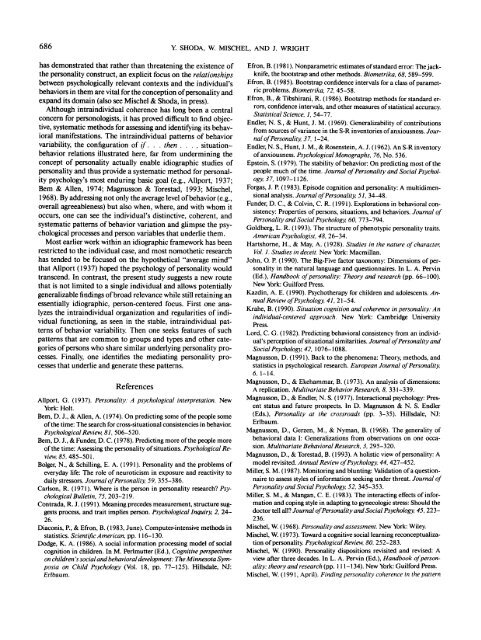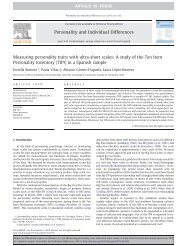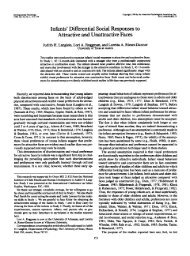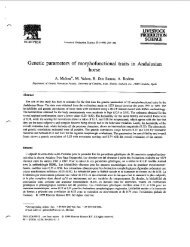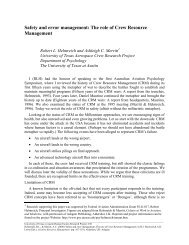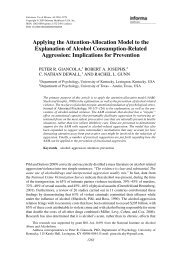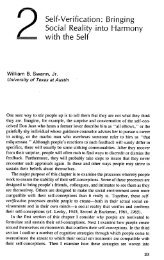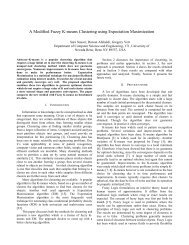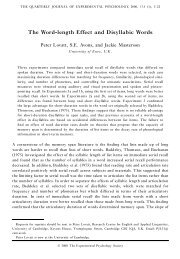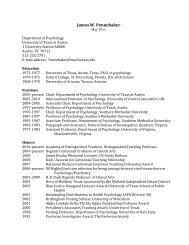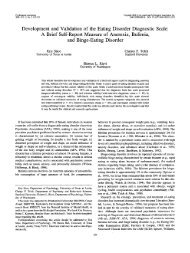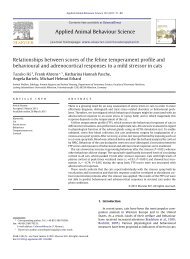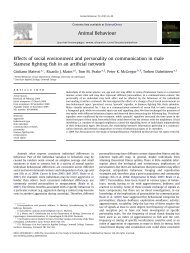PERSONALITY PROCESSES AND INDIVIDUAL DIFFERENCES ...
PERSONALITY PROCESSES AND INDIVIDUAL DIFFERENCES ...
PERSONALITY PROCESSES AND INDIVIDUAL DIFFERENCES ...
You also want an ePaper? Increase the reach of your titles
YUMPU automatically turns print PDFs into web optimized ePapers that Google loves.
686 Y. SHODA, W. MISCHEL, <strong>AND</strong> J. WRIGHT<br />
has demonstrated that rather than threatening the existence of<br />
the personality construct, an explicit focus on the relationships<br />
between psychologically relevant contexts and the individual's<br />
behaviors in them are vital for the conception of personality and<br />
expand its domain (also see Mischel & Shoda, in press).<br />
Although intraindividual coherence has long been a central<br />
concern for personologists, it has proved difficult to find objective,<br />
systematic methods for assessing and identifying its behavioral<br />
manifestations. The intraindividual patterns of behavior<br />
variability, the configuration of if. . . then . . . , situationbehavior<br />
relations illustrated here, far from undermining the<br />
concept of personality actually enable idiographic studies of<br />
personality and thus provide a systematic method for personality<br />
psychology's most enduring basic goal (e.g., Allport, 1937;<br />
Bern & Allen, 1974; Magnusson & Torestad, 1993; Mischel,<br />
1968). By addressing not only the average level of behavior (e.g.,<br />
overall agreeableness) but also when, where, and with whom it<br />
occurs, one can see the individual's distinctive, coherent, and<br />
systematic patterns of behavior variation and glimpse the psychological<br />
processes and person variables that underlie them.<br />
Most earlier work within an idiographic framework has been<br />
restricted to the individual case, and most nomothetic research<br />
has tended to be focused on the hypothetical "average mind"<br />
that Allport (1937) hoped the psychology of personality would<br />
transcend. In contrast, the present study suggests a new route<br />
that is not limited to a single individual and allows potentially<br />
generalizable findings of broad relevance while still retaining an<br />
essentially idiographic, person-centered focus. First one analyzes<br />
the intraindividual organization and regularities of individual<br />
functioning, as seen in the stable, intraindividual patterns<br />
of behavior variability. Then one seeks features of such<br />
patterns that are common to groups and types and other categories<br />
of persons who share similar underlying personality processes.<br />
Finally, one identifies the mediating personality processes<br />
that underlie and generate these patterns.<br />
References<br />
Allport, G. (1937). Personality: A psychological interpretation. New<br />
York: Holt.<br />
Bern, D. J., & Allen, A. (1974). On predicting some of the people some<br />
of the time: The search for cross-situational consistencies in behavior.<br />
Psychological Review, 81, 506-520.<br />
Bern, D. J., & Funder, D. C. (1978). Predicting more of the people more<br />
of the time: Assessing the personality of situations. Psychological Review,<br />
55,485-501.<br />
Bolger, N., & Schilling, E. A. (1991). Personality and the problems of<br />
everyday life: The role of neuroticism in exposure and reactivity to<br />
daily stressors. Journal of Personality, 59, 355-386.<br />
Carlson, R. (1971). Where is the person in personality research? Psychological<br />
Bulletin, 75, 203-219.<br />
Contrada, R. J. (1991). Meaning precedes measurement, structure suggests<br />
process, and trait implies person. Psychological Inquiry, 2, 24-<br />
26.<br />
Diaconis, P., & Efron, B. (1983, June). Computer-intensive methods in<br />
statistics. Scientific American, pp. 116-130.<br />
Dodge, K. A. (1986). A social information processing model of social<br />
cognition in children. In M. Perlmutter (Ed.), Cognitive perspectives<br />
on children's social and behavioral development: The Minnesota Symposia<br />
on Child Psychology (Vol. 18, pp. 77-125). Hillsdale, NJ:<br />
Er/baum.<br />
Efron, B. (1981). Nonparametric estimates of standard error: The jackknife,<br />
the bootstrap and other methods. Biometrika, 68, 589-599.<br />
Efron, B. (1985). Bootstrap confidence intervals for a class of parametric<br />
problems. Biometrika, 72, 45-58.<br />
Efron, B., & Tibshirani, R. (1986). Bootstrap methods for standard errors,<br />
confidence intervals, and other measures of statistical accuracy.<br />
Statistical Science, 1, 54-77.<br />
Endler, N. S., & Hunt, J. M. (1969). Generalizability of contributions<br />
from sources of variance in the S-R inventories of anxiousness. Journal<br />
of Personality, 37, 1-24.<br />
Endler, N. S., Hunt, J. M., & Rosenstein, A. J. (1962). An S-R inventory<br />
of anxiousness. Psychological Monographs, 76, No. 536.<br />
Epstein, S. (1979). The stability of behavior: On predicting most of the<br />
people much of the time. Journal of Personality and Social Psychology,<br />
37, 1097-1126.<br />
Forgas, J. P. (1983). Episode cognition and personality: A multidimensional<br />
analysis. Journal of Personality, 51, 34-48.<br />
Funder, D. C, & Colvin, C. R. (1991). Explorations in behavioral consistency:<br />
Properties of persons, situations, and behaviors. Journal of<br />
Personality and Social Psychology, 60, 773-794.<br />
Goldberg, L. R. (1993). The structure of phenotypic personality traits.<br />
American Psychologist, 48, 26-34.<br />
Hartshorne, H., & May, A. (1928). Studies in the nature of character,<br />
Vol. 1. Studies in deceit. New York: Macmillan.<br />
John, O. P. (1990). The Big-Five factor taxonomy: Dimensions of personality<br />
in the natural language and questionnaires. In L. A. Pervin<br />
(Ed.), Handbook of personality: Theory and research (pp. 66-100).<br />
New York: Guilford Press.<br />
Kazdin, A. E. (1990). Psychotherapy for children and adolescents. Annual<br />
Review of Psychology, 41, 21-54.<br />
Krahe, B. (1990). Situation cognition and coherence in personality: An<br />
individual-centered approach. New York: Cambridge University<br />
Press.<br />
Lord, C. G. (1982). Predicting behavioral consistency from an individual's<br />
perception of situational similarities. Journal of Personality and<br />
Social Psychology, 42, 1076-1088.<br />
Magnusson, D. (1991). Back to the phenomena: Theory, methods, and<br />
statistics in psychological research. European Journal of Personality,<br />
6, 1-14.<br />
Magnusson, D., & Ekehammar, B. (1973). An analysis of dimensions:<br />
A replication. Multivariate Behavior Research, 8, 331-339.<br />
Magnusson, D., & Endler, N. S. (1977). Interactional psychology: Present<br />
status and future prospects. In D. Magnusson & N. S. Endler<br />
(Eds.), Personality at the crossroads (pp. 3-35). Hillsdale, NJ:<br />
Erlbaum.<br />
Magnusson, D., Gerzen, M., & Nyman, B. (1968). The generality of<br />
behavioral data I: Generalizations from observations on one occasion.<br />
Multivariate Behavioral Research, 3, 295-320.<br />
Magnusson, D., & Torestad, B. (1993). A holistic view of personality: A<br />
model revisited. Annual Review of Psychology, 44,427-452.<br />
Miller, S. M. (1987). Monitoring and blunting: Validation of a questionnaire<br />
to assess styles of information seeking under threat. Journal of<br />
Personality and Social Psychology, 52, 345-353.<br />
Miller, S. M., & Mangan, C. E. (1983). The interacting effects of information<br />
and coping style in adapting to gynecologic stress: Should the<br />
doctor tell all? Journal of Personality and Social Psychology, 45, 223-<br />
236.<br />
Mischel, W. (1968). Personality and assessment. New York: Wiley.<br />
Mischel, W. (1973). Toward a cognitive social learning reconceptualization<br />
of personality. Psychological Review, 80, 252-283.<br />
Mischel, W. (1990). Personality dispositions revisited and revised: A<br />
view after three decades. In L. A. Pervin (Ed.), Handbook of personality:<br />
theory and research (pp. 111 -134). New York: Guilford Press.<br />
Mischel, W. (1991, April). Finding personality coherence in the pattern


